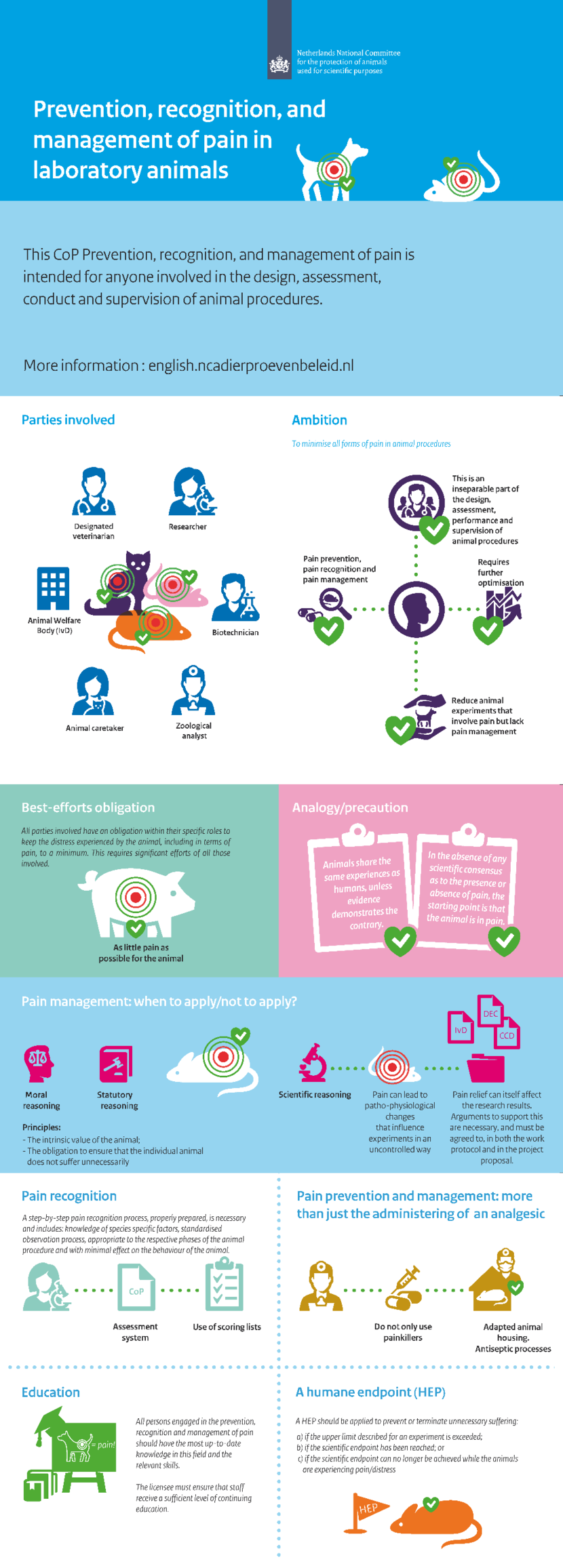Prevention, recognition, and management of pain in laboratory animals
This CoP Prevention, recognition, and management of pain is intended for anyone involved in the design, assessment, conduct and supervision of animal procedures.
More information: english.ncadierproevenbeleid.nl
Parties involved
Designated veterinarian
Researcher
Animal Welfare Body (IvD)
Biotechnician
Animal caretaker
Zoological analyst
Ambition
To minimise all forms of pain in animal procedures
This is an inseparable part of the design, assessment, performance and supervision of animal procedures
Requires further optimization
Reduce animal experiments that involve pain but lack pain management
Pain prevention, pain recognition and pain management
Best-efforts obligation
All parties involved have an obligation within their specific roles to keep the distress experienced by the animal, including in terms of pain, to a minimum. This requires significant efforts of all those involved.
As little pain as possible for the animal
Analogy/precaution
Animals share the same experiences as humans, unless evidence demonstrates the contrary.
In the absence of any scientific consensus as to the presence or absence of pain, the starting point is that the animal is in pain.
Pain management: when to apply/not to apply?
Moral Reasoning
Statutory Reasoning
Principles:
- The intrinsic value of the animal;
- The obligation to ensure that the individual animal does not suffer unnecessarily
Scientific reasoning
Pain can lead to pathophysiological changes that influence experiments in an uncontrolled way
Pain relief can itself affect the research results. Arguments to support this are necessary, and must be agreed to, in both the work protocol and in the project proposal.
Pain recognition
A step-by-step pain recognition process, properly prepared, is necessary and includes: knowledge of species-specific factors, standardised observation process, appropriate to the respective phases of the animal procedure and with minimal effect on the behaviour of the animal.
Assessment system
Use of scoring lists
Pain prevention and management: more than just the administering of an analgesic
Do not only use painkillers
Adapted animal housing. Antiseptic processes
Education
All persons engaged in the prevention, recognition and management of pain should have the most up-to-date knowledge in this field and the relevant skills.
The licensee must ensure that staff receive a sufficient level of continuing education.
A humane endpoint (HEP)
A HEP should be applied to prevent or terminate unnecessary suffering:
a) if the upper limit described for an experiment is exceeded;
b) if the scientific endpoint has been reached; or
c) if the scientific endpoint can no longer be achieved while the animals are experiencing pain/distress
